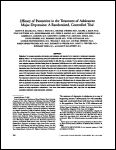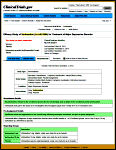My preacher friend Andy had a book, The Concordance, that showed the four gospels with their different accounts of the same event aligned to be side by side. I liked the idea, and used it in my own teaching on a very different topic. But in this case, I’m co-opting the term to say that these four documents should be a Concordance, say the same thing, reach the same conclusions:
 |
 |
 |
 |
| published journal article |
clinicaltrials.gov results database |
fda medical and statistical reviews |
raw data [IPD, CRF] |
Under the current arrangement, the only entities that have actually seen and analyzed the raw data from a clinical trial of an FDA regulated drug are the trial sponsors and the FDA. The FDA has extensively analyzed the data itself and said either yeah or nay to a new drug application or an approval for a new indication of an approved drug. That they keep the raw data a secret is something I would argue with, but for the moment, it is a longstanding convention so I wouldn’t get very far with my argument. They are giving in to the Subject Privacy and Commercially Confidential Information [CCI] arguments.
But the FDA silence goes deeper than that. They alone know the results of the prespecified Primary and Secondary Outcome variable analysis, yet have remained silent as our literature fills up with journal articles that deliberately distort those results – have remained silent as clinicaltrials.gov‘s results database has been ignored. So by remaining silent, the FDA, the agency charged with insuring that our pharmaceutical formulary is both safe and effective, the only agency that has access to the definitive clinical trial data and the results of its analysis, has been an active partner in the corrupt journal trial reports that have swept through our medical literature. Likewise, the NIH has also been a party to the corruption by being passive while their clinicaltrials.gov results database has been systematically ignored, even in situations where reporting is mandatory.
This is a giant loophole in the system. Whether through passivity or feeling they didn’t have the mandate or authority, the FDA and NIH have become a major part of this problem by remaining silent, being passive. And there is a solution:
|
1boringoldman Simple Facts
|
|
On the day that a sponsor and authors submit an article about their clinical trial to a journal, they already have the results at their fingertips. There is no reason that they could not easily post the required results on the clinicaltrials.gov results database…
|
|
|
|
On the day that the clinicaltrials.gov results database is populated, the FDA already has their own results at their fingertips. There is no reason that they could not easily check for concordance between those posted by the sponsor and their own analysis, and add their findings as a commentary to the results database.
|
|
|
|
In this scenario, the journal editors and peer reviewers still wouldn’t have the raw data, but they would have the results and a commentary about those results in hand which would bring their decision making process into the realm of evidence based medicine.
|
|
|
|
By taking an active role in this process, the FDA would be stepping up to the plate in fulfilling its broad charge of insuring safety, efficacy, and integrity to clinical trial reporting landscape, and they could do this without compromising either subject confidentiality or commercially confidential information.
|
Last week, the FDA, NIH, and clinicaltrials.gov announced broad changes directly addressing the problem of corrupt clinical trial reporting. They are to be commended for their initiative and many of their changes. But they didn’t plug the loophole being discussed here – publicly addressing Concordance among the versions of the results, with coordination between agencies, and with surveillance and enforcement.
Sorry, the comment form is closed at this time.